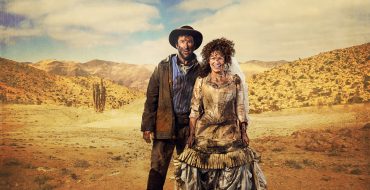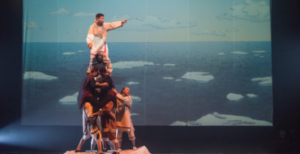The central question swirling around Bard on the Beach’s current production of The Taming of the Shrew is – why? Why exhume a comedy about a woman debased and mocked for her fiery, uncompromising independence? Bard On The Beach’s Wild West rendition of Shakespeare’s tone-deaf romcom tries to provide an entertaining answer, but mostly succeeds at raising more questions about how far we can stretch our imagination to laugh at something that also leaves audiences cringing a little.
Following up on last year’s winning production of Lysistrata, director Lois Anderson has set herself a more difficult task with The Taming of the Shrew. It feels like the play is in need of radical changes, so to start Anderson sets it in the 1870s. The Western has always been a genre that easily lends itself to tales of revenge and in this sense, it’s an ideal choice for Kate, the shrew’s, mistreatment and triumphant return. Anderson has fun re-making Shakespeare’s Padua into an uptight frontier town with swaggering, gun-toting suitors and rival sisters tussling by lasso. Although charming, these changes may not go far enough to make this play speak to our present moment.
Despite the play’s difficult premise, Bard’s superlative set and costume design team keep things interesting and moving on multiple levels. Mara Gottler’s costumes shine, especially when the characters require over-the-top moments of braggadocio. Kate’s transformation from infamous shrew to triumphant cowgirl is carefully tracked by her ever-evolving costume. At one moment resembling a spinster dressed in black and the next morphing into a free-wheeling frontier gun-slinger, Kate’s clothes attempt to make sense of her evolution, a shift that the play’s plot does less to address.
This spaghetti western flare is also evident in the sound and music design by Malcolm Dow. Dow has smartly re-purposed late Bard composer Marc Desormeaux’s music into a series of vampy Ballad-of-Buster-Scruggs cues that often steal the show. Sound effects also arrive as galloping horses, wailing coyotes and singing crickets to complete the frolicking Wild West ambience. The production’s stage design by Cory Sincennes invokes western iconography with an equal wink to the Alamo, shoot ‘em up saloons and quaint country fair pie contests.
But all this is only window dressing for the tortured Kate. The play’s central action revolves around the Minola sisters. Katherine must be wed before Biana, her flirtatious and docile younger sibling, can accept one of many marriage proposals. Jennifer Lines is ferocious in the titular role. From her first appearance onstage, caterwauling across the balcony and brandishing a shotgun, she sounds a note of loud defiance.
As suitors machinate ways to win the younger woman’s hand, one bold cowboy steps forward to offer himself up as Kate’s match. Petrucio, played with panache by Andrew McNee, plans to marry Kate for her large dowry despite warnings from fellow cowboys. As with many characters in this play, money is the animating consideration, but this can only explain so much. After humiliating her by showing up late, half-naked and half drunk at their wedding Petrucio spirits Kate away to his cowboy camp to begin her “taming” with no food and no sleep. These deprivations do the trick as Kate falls in love with her captor. Is listening to cowboy songs around the campfire, really enough to cause a change of heart? You have to accept these mysteries to enjoy the play.
Shakespeare has written a comedy with the familiar set of mistaken identities and lovers in disguise that keeps the plot humming along. All these details are lovingly rendered, but little is offered that speaks to the central characters’ motivation. Why would Kate fall in love with Petrucio?
The production’s telling of the weddings that punctuate this play’s ending are satisfying though. Without too many spoilers, Kate sheds her prim and proper wife look for an outlaw’s badassery and bravado. This transformation is stirring, but leaves one wondering what more this hero has to say after she’s exacted her revenge and the guns are back in their holsters.
Bravo to Bard on the Beach for breathing new life into The Taming of the Shrew, but taking it into the 1870s may not be far enough to make it relevant to our times. What’s a shrew to do? We can only gaze at the moon with the coyotes and wonder.









